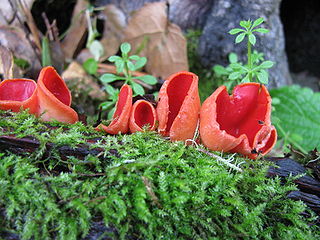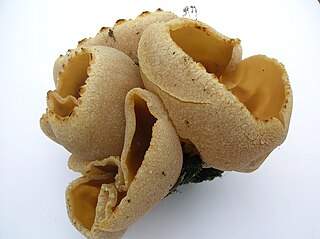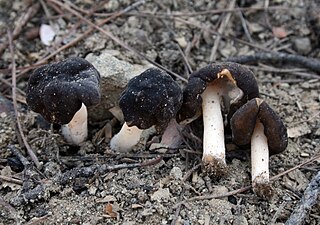
Sarcoscypha coccinea, commonly known as the scarlet elf cup, scarlet elf cap, or the scarlet cup, is a species of fungus in the family Sarcoscyphaceae of the order Pezizales. The fungus, widely distributed in the Northern Hemisphere, has been found in Africa, Asia, Europe, North and South America, and Australia. The type species of the genus Sarcoscypha, S. coccinea has been known by many names since its first appearance in the scientific literature in 1772. Phylogenetic analysis shows the species to be most closely related to other Sarcoscypha species that contain numerous small oil droplets in their spores, such as the North Atlantic island species S. macaronesica. Due to similar physical appearances and sometimes overlapping distributions, S. coccinea has often been confused with S. occidentalis, S. austriaca, and S. dudleyi.

The Stictidaceae are a family of fungi in the order Ostropales. The family was first described by Swedish mycologist Elias Magnus Fries in 1849.

Peziza praetervisa, commonly known as the purple fairy cup or the fireplace cup, is a species of fungus in the genus Peziza, family Pezizaceae. Recognized by its flattened, purple, cup-like fruitbodies, this widespread fungus typically grows scattered or in clusters on burnt ground.
Yarrowia is a fungal genus in the family Dipodascaceae. For a while the genus was monotypic, containing the single species Yarrowia lipolytica, a yeast that can use unusual carbon sources, such as hydrocarbons. This has made it of interest for use in industrial microbiology, especially for the production of specialty lipids. Molecular phylogenetics analysis has revealed several other species that have since been added to the genus.

Sarcosphaera is a fungal genus within the Pezizaceae family. It is a monotypic genus, containing the single species Sarcosphaera coronaria, commonly known as the pink crown, the violet crown-cup, or the violet star cup. It is a whitish or grayish cup fungus, distinguished by the manner in which the cup splits into lobes from the top downward. It is commonly found in the mountains in coniferous woods under humus on the forest floor, and often appears after the snow melts in late spring and early summer. The fungus is widespread, and has been collected in Europe, Israel and the Asian part of Turkey, North Africa, and North America. In Europe, it is considered a threatened species in 14 countries. Although several taxa have been described as Sarcosphaera species since the introduction of the genus in 1869, most lack modern descriptions, have been transferred to the related genus Peziza, or are considered synonymous with S. coronaria.

Ruhlandiella is a genus of fungi within the family Pezizaceae. Ruhlandiella species are exothecial hypogeous fungi, which are essentially truffles that lack the outer layer or peridium. Ruhlandiella species are widely distributed in Nothofagaceae forests in South America and near Eucalyptus or Melaleuca plants in Australia, North America, and Europe.
Marcelleina is a genus of fungi within the Pezizaceae family. The genus was circumscribed in 1967.

Peziza cerea, commonly known as the Cellar Cup is a species of Ascomycete fungus in the genus Peziza, family Pezizaceae. In common with other Ascomycetes the upper surface of the fungus has a layer of cylindrical spore producing cells called asci, from which the ascospores are forcibly discharged.

Otidea is a genus of fungi in the family Pyronemataceae. The genus is widely distributed in northern temperate regions.

Persoonia rigida, commonly known as the rigid-, hairy- or stiff geebung, is a species of flowering plant in the family Proteaceae and is endemic to south-eastern Australia. It is an erect to low-lying shrub with hairy young branchlets, lance-shaped to spatula-shaped leaves that are hairy when young, and yellow flowers borne in groups of up to twenty on a rachis up to 90 mm (3.5 in) long that continues to grow after flowering.

Peziza domiciliana, commonly known as the domicile cup fungus, is a species of fungus in the genus Peziza, family Pezizaceae. Described by English mycologist Mordecai Cubitt Cooke, the fungus grows on rotten wood, drywall/plasterboard, and plaster in homes, damp cellars, and basements. It is known from Asia, Europe, North America, and Antarctica.

Peziza succosa is a species of apothecial fungus belonging to the family Pezizaceae. It grows in woods in Europe, Iceland, Israel, China, Argentina, and the United States. In Europe this fungus appears in summer and autumn as grey or brown saucers up to 10 cm (3.9 in) in diameter on soil in woodland, often at pathsides. In the United States, this type of cup fungi may also be found on decaying deciduous wood. It is inedible.
Hubertus Antonius van der Aa was a Dutch mycologist who described several genera and species of fungi. He studied at Utrecht University where he received his PhD in 1973 with the dissertation Studies in phyllosticta I.

Teratosphaeriaceae is a family of fungi in the order Capnodiales.

Peziza fimeti is a species of ascomycete fungus belonging to the family Pezizaceae. Found in Europe and North America, the fungus grows on cow dung. It produces small, light brown, cup-shaped fruit bodies up to 2 cm (0.8 in) in diameter. The asci are cylindrical, with dimensions of up to 280 µm long and 18 µm in diameter. The spores are ellipsoid and measure 8 by 16 µm.

Cudoniella clavus is a species of fungus in the family Helotiaceae. It was first described in 1805 by Johannes Baptista von Albertini and Lewis David de Schweinitz as Peziza clavus. British mycologist R. W. G. Dennis transferred it to Cudoniella in 1964. Fruit bodies of the fungus consist of a disc-like cap measuring 0.4–1.2 cm (0.16–0.47 in) with a thin stipe. They grow on rotting twigs, stems, leaves, and cones that are submerged in water. Cudoniella clavus is a widespread and common species. It is inedible.
Pedro Willem Crous is a South African mycologist and plant pathologist.

Gyromitra anthracobia is a post-fire ascomycete fungus in the family Discinaceae. It was described as new to science in 2018 from recently burned forests on the island of Cyprus.
Collariella bostrychodes is a fungal decomposer of lignin and carbohydrate in the family Chaetomiaceae commonly found in soil and dung. The fungus is distinguished by a darkened collar-like ostiole around the ostiolar pore, giving the fungus its name. The fungus is highly variable in shape and form, giving raise to the belief that there are two subclades in the species. The ascospores range from lemon-shaped to nearly spherical with slightly pointed ends. It can grow to be pale green and later turn pale bluish grey or olivaceous with age. The fungus produces the toxic secondary metabolite, chaetochromin.

Cordieritidaceae is a family of fungi in the order Cyttariales. Species in this family are saprobes or lichenicolous.















